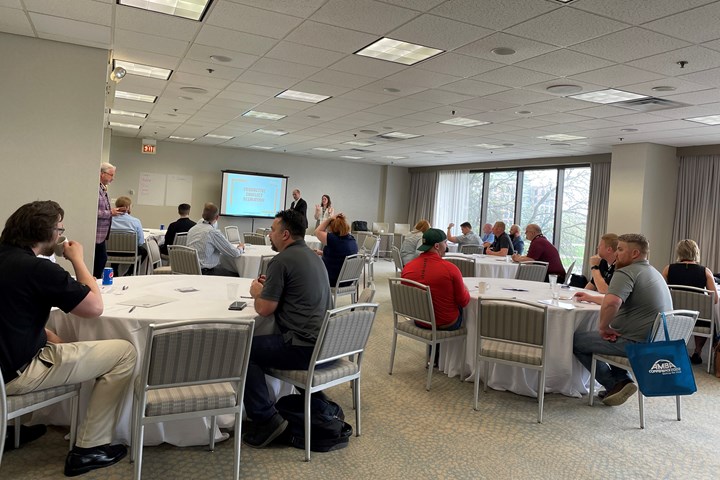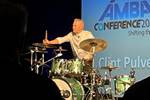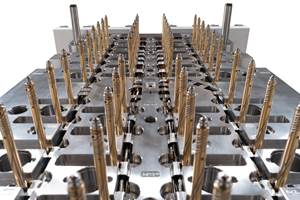Building Molds and Legacies
Being a leader or becoming a leader isn’t just about the end product, but the people you’re leading and the history you’re making. This also means learning how to identify, address and mitigate conflict.

AMBA 2022 Emerging Leaders Precon Session. Photo Credit: MMT
What is a leader? That was the first question posed to us during the American Mold Builders Association’s 2022 Emerging Leaders Pre-Con Session sponsored by Sandler Training | EAM Consulting Group, a question that — it soon became abundantly clear — would embody the duration of the three-day conference.
It seemed like such a simple answer at first; I can imagine that for many of the next-generation AMBA members sitting in that room, including myself, our preconceived notions took the form of an owner, CEO or manager, someone in the hierarchy of high-standing positions that, as a direct result, led the company, or made the big decisions.
But this was where we were wrong. Leaders can and have taken the form of a higher up, but that does not mean this made them leaders. In fact, most people and organizations, according to Jeremiah Sinks, workforce development specialist from Purdue Manufacturing Extension Partnership (MEP), are over-managed and over-led. These traits themselves soon lead to a perceived notion as a “boss,” which in itself reflects negative connotations to employees, and, consequentially, leads to a waterfall effect of other problems, including conflict. Then this conflict costs a company its relationship development, efficiency, production and culture, all very real and ongoing pain points in mold shops.
Control your controllables, audit the work environment (do you say what you will do and then take action?) and develop relationships with your employees.
Leaders lead. They “get the willing participation of others to follow their visions.” They pull people together. What they don’t do is manage people, pushing them into place, ruling by fear, dissent or both.
Nor does being a leader mean that only those in high-standing positions can become them. Sitting in that room, many of those attending — apprentices, supervisors, programmers, machine operators, project managers — had to ask themselves: What kind of leaders are we? What kind of leaders do we want to become? What kind of leaders can we become?
Through three hours of peer interaction and discussion, we learned to start the process of shifting our own perspectives — about ourselves and those we surround ourselves with at our organizations. Some of the most significant takeaways I left with are:
- You have to start addressing conflict now. Some of the real issues that negative conflict has affected cited by others in the session include communication, meeting deadlines and personal/independent motivations (shift warfare). If it’s not identified and addressed sooner rather than later, consequences can only worsen.
- Not all conflict is bad. There is a difference between “healthy tension” (i.e., healthy competition), but only in small doses. Anything more and it can turn into toxic stress.
- Don’t blame the people, blame the process. We often put 96% effort into who messed it up and only 4% to solve the process pain point. Ask yourself: Who is really driving the root cause of the problem? Why? More often than not, it stems from something more complex than the individual.
- R = Q + A. Quality and acceptance (of employees) equals results.
- There is no perfect answer to eliminating all conflict. It’s not about elimination, it’s about mitigation. Control your controllables, audit the work environment (do you say what you will do and then take action?) and develop relationships with your employees.
- Products are important, but so is your legacy. What kind of legacy will you build as a leader and leave behind? Will it be negative or positive?
In the pre-con session, individuals were vulnerable, sharing examples or scenarios experienced in their own organizations. By identifying some of these challenges, it was made very clear to me that the up-and-coming leaders in that room actively wanted to learn and improve upon them. Already the gears were turning in their heads: What could they do to address the conflict they were already seeing? What kind of response styles could they use to approach it and what positive or negative effects would come out of it?
But more importantly, they were proactively seeking how to become better leaders.
Related Content
Questions and Considerations Before Sending Your Mold Out for Service
Communication is essential for proper polishing, hot runner manifold cleaning, mold repair, laser engraving and laser welding services.
Read MoreMachine Hammer Peening Automates Mold Polishing
A polishing automation solution eliminates hand work, accelerates milling operations and controls surface geometries.
Read MoreHow to Use Scientific Maintenance for More Accurate Mold and Part Troubleshooting
Discover how adopting scientific maintenance approaches helps improve mold lifespan, minimize failures, and optimize production outcomes.
Read MoreHow to Solve Hot Runner Challenges When Molding with Bioresins
A review of the considerations and adaptations required to design hot runners and implement highly productive injection molding operations.
Read MoreRead Next
Shift Your View: Get to Know the Stories of Your Team and Transform Your Shop
It’s simple but true and worth repeating — don't judge a book by its cover. Instead, always make an effort to get to know a person, especially if that person is working in your shop.
Read MoreAre You a Moldmaker Considering 3D Printing? Consider the 3D Printing Workshop at NPE2024
Presentations will cover 3D printing for mold tooling, material innovation, product development, bridge production and full-scale, high-volume additive manufacturing.
Read MoreHow to Use Continuing Education to Remain Competitive in Moldmaking
Continued training helps moldmakers make tooling decisions and properly use the latest cutting tool to efficiently machine high-quality molds.
Read More




















